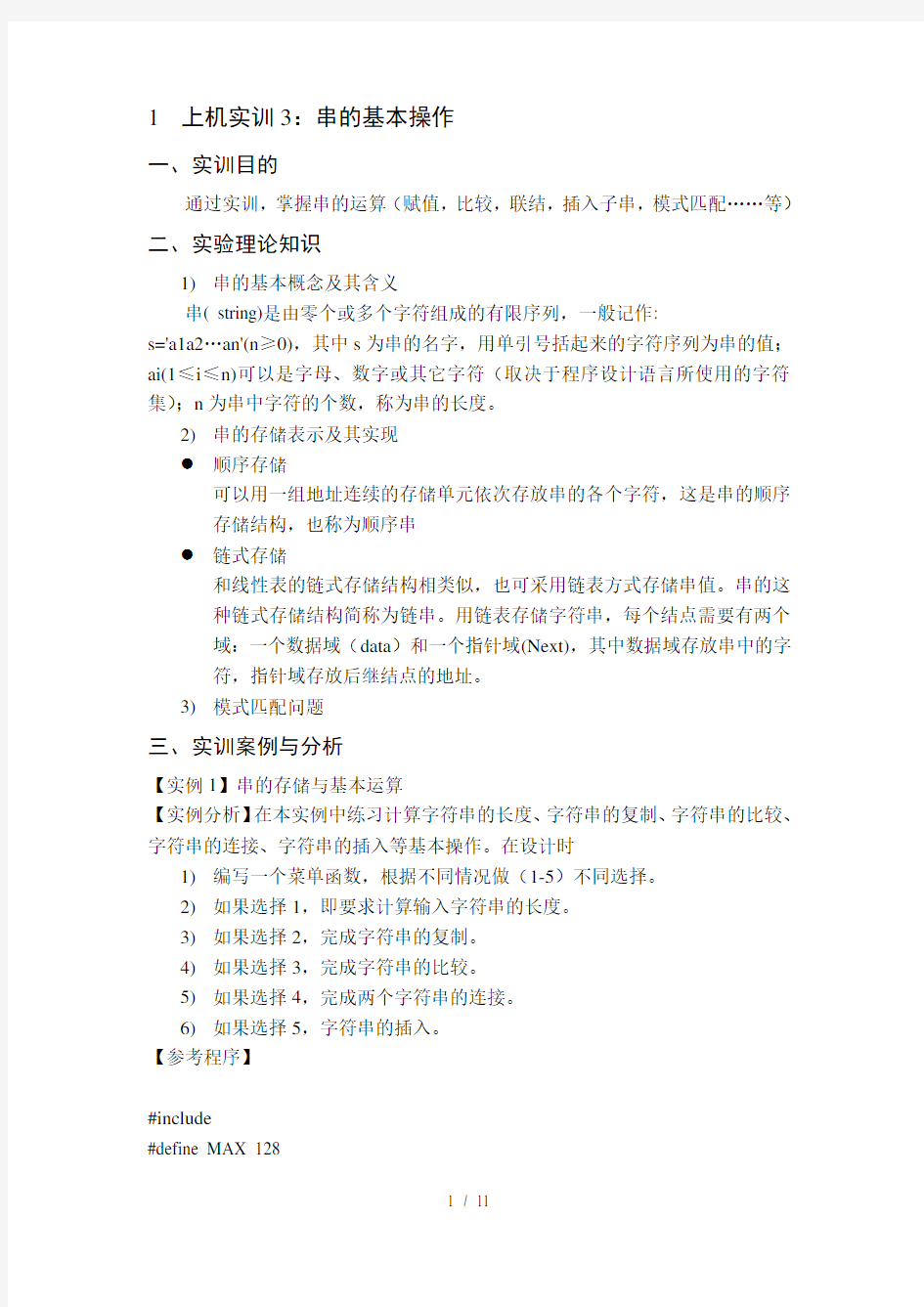

1上机实训3:串的基本操作
一、实训目的
通过实训,掌握串的运算(赋值,比较,联结,插入子串,模式匹配……等)
二、实验理论知识
1)串的基本概念及其含义
串( string)是由零个或多个字符组成的有限序列,一般记作:
s='a1a2…an'(n≥0),其中s为串的名字,用单引号括起来的字符序列为串的值;ai(1≤i≤n)可以是字母、数字或其它字符(取决于程序设计语言所使用的字符集);n为串中字符的个数,称为串的长度。
2)串的存储表示及其实现
●顺序存储
可以用一组地址连续的存储单元依次存放串的各个字符,这是串的顺序
存储结构,也称为顺序串
●链式存储
和线性表的链式存储结构相类似,也可采用链表方式存储串值。串的这
种链式存储结构简称为链串。用链表存储字符串,每个结点需要有两个
域:一个数据域(data)和一个指针域(Next),其中数据域存放串中的字
符,指针域存放后继结点的地址。
3)模式匹配问题
三、实训案例与分析
【实例1】串的存储与基本运算
【实例分析】在本实例中练习计算字符串的长度、字符串的复制、字符串的比较、字符串的连接、字符串的插入等基本操作。在设计时
1)编写一个菜单函数,根据不同情况做(1-5)不同选择。
2)如果选择1,即要求计算输入字符串的长度。
3)如果选择2,完成字符串的复制。
4)如果选择3,完成字符串的比较。
5)如果选择4,完成两个字符串的连接。
6)如果选择5,字符串的插入。
【参考程序】
#include
#define MAX 128
typedef enum {fail,success} status;
typedef enum {false,true} boolean;
main()
{ int strlen();
void strass();
boolean strcmp();
status strcat( );
status strins();
int t,n,i;
boolean b;
status st;
char s[MAX],s1[MAX],s2[MAX];
printf("\n1. The length of string\n");
printf(" 2. The assignment of string\n");
printf(" 3. A string compare with another string:\n"); printf(" 4. A string connect with another string:\n"); printf(" 5. A string to be inserted into another string\n"); printf(" Please input a operation:");/*输入操作选项*/ scanf("%d",&t);
switch(t)
{
case 1:
printf("please input a string:\n");
getchar();
gets(s);
n=strlen(s);
printf("the length is: %d",n);
break;
case 2:
printf("please input the first string:\n");
getchar();
gets(s1);
printf("please input the second string:\n");
getchar();
gets(s2);
strass(s1,s2);
break;
case 3:
printf("please input the first string:\n"); getchar();
gets(s1);
printf("please input the second string: \n"); gets(s2);
b=strcmp(s1,s2);
if (b==true)
printf("equal\n");
else
printf("not equal\n");
break;
case 4:
printf("please input the first string:\n"); getchar();
gets(s1);
printf("please input the second string:\n"); gets(s2);
st=strcat(s1,s2);
if(st==success)
printf("answer is %s\n",s1);
else
printf("error!\n");
break;
case 5:
printf("please input the first string:\n"); getchar();
gets(s1);
printf("please input the second string:\n"); gets(s2);
printf("please input i:");
scanf("%d",&i);
st=strins(s1,i,s2);
if(st==success)
printf("answer is: %s\n",s1);
else printf("error!\n");
break;
case 0:break;
default: printf("There isn't this operation!");
}
}
int strlen(s) /*求字符串的长度子函数*/
char s[];
{ int i;
for(i=0;s[i]!='\0';i++);
return (i);
}
void strass(s1,s2)
char s1[],s2[];
{ int i=0;
while(s1[i]!='\0')
{ s2[i]=s1[i];
i++;
}
s2[i]='\0';
printf("s2 is %s",s2);
}
boolean strcmp(s1,s2) /*字符串比较子函数*/ char s1[],s2[];
{ int i=0;
while (s1[i]==s2[i] && s1[i]!='\0' && s2[i]!='\0') i++;
if (s1[i]=='\0' && s2[i]=='\0')
return (true);
else
return (false);
}
status strcat (s1,s2) /*字符串连接子函数*/
char s1[],s2[];
{ int i,j,k;
i=strlen(s1);
j=strlen(s2);
if((i+j)>=MAXN)
return(fail);
for(k=0;k<=j;k++)
s1[i+k]=s2[k];
return (success);
}
status strins (s1,i,s2)
char s1[],s2[];
int i;
{ int m,n,k;
m=strlen(s1);
n=strlen(s2);
if (i<0||i>m||(m+n)>MAXN )
return (fail) ;
for(k=m;k>=i;k--)
s1[k+n]=s1[k];
for(k=0;k s1[i+k]=s2[k]; return (success); } 【测试数据与结果:】 计算字符串的长度 1. The length of string 2. The assignment of string 3. A string compare with another string: 4. A string connect with another string: 5. A string to be inserted into another string Please input a opertation:1 please input a string: you are a boy! the length is: 14 字符串的复制 1. The length of string 2. The assignment of string 3. A string compare with another string: 4. A string connect with another string: 5. A string to be inserted into another string Please input a opertation:2 please input the first string: you are a boy! please input the second string: i am a girl! s2 is you are a boy! 字符串的比较 1. The length of string 2. The assignment of string 3. A string compare with another string: 4. A string connect with another string: 5. A string to be inserted into another string Please input a opertation:3 please input the first string: you are a boy! please input the second string: i am a girl! not equal 字符串的连接 1. The length of string 2. The assignment of string 3. A string compare with another string: 4. A string connect with another string: 5. A string to be inserted into another string Please input a opertation:4 please input the first string: you are a boy! please input the second string: i am a girl! answer is:you are a boy!i am a girl! 字符串的插入 1. The length of string 2. The assignment of string 3. A string compare with another string: 4. A string connect with another string: 5. A string to be inserted into another string Please input a opertation:5 please input the first string: you are a boy! please input the second string: i am a girl! please input i:2 answer is i am a girl! you are a boy! 【实例2】统计主串指定单词在主串中出现的次数和位置 【实例描述】统计主串指定单词在主串中出现的次数和位置,要求: 1)输入以回车作为结束符的一串字符作为主串; 2)求主串中指定单词出现的次数和位置,注意单词与子串的区别; 【实例分析】 假设num存放出现次数,初始化为0,position[i]存放每一次匹配时的位置。 1)编写一个菜单函数,根据不同情况做(0-3)不同选择 2)如果选择1,即要求匹配的是单个字符c,让i=0,依次比较主串的第i 个字符,如果s[i]==c,则匹配成功,position[num]=i;num++; 3)如果选择2,即要求匹配的是子串t,则此算法即为模式匹配算法,与模 式匹配不同的是每次匹配成功时不是返回,而是设置position和num的 值,position[num]=i-j;num++; 4)如果选择3,即要求匹配的是单词t,假设主串中单词之间用空格分割, 此算法与3)的不同,与t匹配的子串必须是一个单词,因此首先要找出 主串中的单词,然后让t与找到的单词比较,若结果相等,则匹配成功,设置position和num的值,position[num]=i-j; num++;否则,查找主串中 的下一个单词,直到主串结束。 【实例实现】 #include "string.h" #include "stdio.h" char str[60]; void menu() /*菜单选择函数*/ {char choice,c; char t[20]; printf(" 指定类型\n"); printf("====================\n"); printf("1.单个字符\n"); printf("2.指定子串\n"); printf("3.指定单词\n"); printf("0.退出\n"); printf("====================\n"); do { printf("请你在上述功能中选择(0-3) : "); choice=getchar(); getchar(); switch(choice) {case '1':printf("input char : "); /*指定单个字符匹配的情况*/ c=getchar();getchar(); index_char(str,c); break; case '2':printf("input string : "); /*指定子串匹配的情况*/ gets(t); index_string(str,t);break; case '3':printf("input word : "); /*指定单词匹配的情况*/ gets(t); index_word(str,t);break; case '0':return; } }while(1); } index_string(char *s,char *t) /*子串匹配函数*/ {int i,j,num=0,position[80]; /*num存放匹配个数,position中存放每一次匹配的位置*/ i=0;j=0; while(s[i]!='\0') /*主串没有结束*/ {while(s[i]!='\0'&&t[j]!='\0') /*没有遇到结束符*/ if(s[i]==t[j]) /*继续*/ {i++; j++;} else /*回溯*/ {i=i-j+1; j=0; } if(t[j]=='\0') {position[num]=i-j;num++;j=0;} /*匹配成功,存放位置,并且次数加1*/ } if(num) /*如果匹配成功,输出匹配次数和位置*/ {printf("\nthe number of string \"%s\" is %d",t,num); printf("\nthe position is:"); for(i=0;i printf("%5d",position[i]); printf("\n");} else printf("\n the string is not found!",i); } index_word(char *s,char *t) {int i,j,num=0,position[80]; char word[20]; i=j=0; while(s[i]!='\0') {j=0; while(s[i]==' ') i++; while((s[i]!=' ')&&(s[i]!='\0')) /*寻找主串中的单词*/ word[j++]=str[i++]; word[j]='\0'; if(strcmp(t,word)==0) /*如果输入的单词与主串中的单词匹配*/ {position[num]=i-j;num++;} } if(num) /*如果匹配成功,输出匹配次数和位置*/ { printf("\nthe number of word \"%s\" is %d",t,num); printf("\nthe position is:"); for(i=0;i printf("%5d",position[i]); printf("\n"); } else printf("\n the word is not found!"); } index_char(char *s,char t) { int i=0,num=0,position[80]; while(s[i]!='\0') {if(s[i]==t) {position[num]=i;num++;} i++;} if(num) { printf("\nthe number of char ' %c' is %d",t,num); printf("\nthe position is:"); for(i=0;i printf("%5d",position[i]); printf("\n"); } else printf("\n the char is not found!");